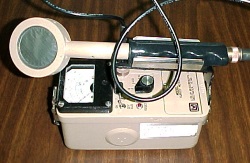 Calibration is the process by which a quantitative measuring instrument is manipulated to respond and indicate a certain range of acceptable values. Accurate instrument calibration and its proper use is fundamental in a clinical or research laboratory program. Proper calibration ensures that meters can accurately detect radiation. It is also important to understand what is being calibrated and how the calibration is being performed. In this article, we will be discussing calibration of radioactive detecting instruments.
Calibration is the process by which a quantitative measuring instrument is manipulated to respond and indicate a certain range of acceptable values. Accurate instrument calibration and its proper use is fundamental in a clinical or research laboratory program. Proper calibration ensures that meters can accurately detect radiation. It is also important to understand what is being calibrated and how the calibration is being performed. In this article, we will be discussing calibration of radioactive detecting instruments.Radioactive detecting instruments function by detecting radioactive energy by various processes, however they are only able to detect a percentage of the energy that is being emitted. For example, a radioactive nuclide may emit 100,000 particles in one minute; the detection instrument may only see .05%, or 50 particles in that minute and that is called efficiency. Efficiency of an instrument varies from isotope to isotope, and from instrument to instrument.
Consequently, It can be assumed that if the instrument only sees a portion of the available detectable particles that the instrument needs to be calibrated correctly to see that portion. Therefore, it is important to be able to extrapolate the correct number from the observed number. Using the above example, you might conclude that a reading of 50 observed counts in one minute means that there were really about 100,000 counts.
Calibration measures the instrument's response to a known number of counts. During calibration certain factors are minimized or all together eliminated that may cause inaccurate measurements. This is a fundamental aspect of instrumentation design.
Calibration outlines the accuracy and quality of measurements recorded using a piece of equipment or a radioactive isotope. Over time there is a tendency for results and accuracy to 'float' particularly when measuring particular parameters such as temperature and humidity. For one to be confident in the results being measured there is an ongoing need to calibrate the equipment throughout its lifetime for accurate, reliable, and repeatable measurements.
The UAB Radiation Safety Program provides the service of annual radiological survey instrument calibration to the UAB community.

